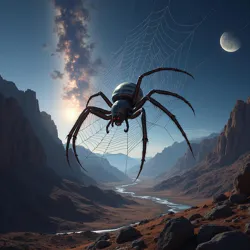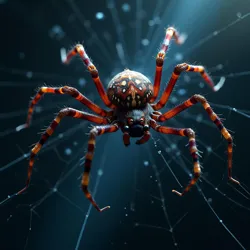Nebula Orb Weaver
 A massive metallic web constructed by a Nebula Orb Weaver spans across a valley on Kepler-447b, illuminated by the planet's twin moons
A massive metallic web constructed by a Nebula Orb Weaver spans across a valley on Kepler-447b, illuminated by the planet's twin moonsThe Nebula Orb Weaver (Arachnius stellaris magnificens) is a remarkable species of giant spider native to the low-gravity environments of Kepler-447b. Most famous for holding the record for largest recorded web in the Arachnid Book of World Records, these extraordinary arachnids have evolved unique adaptations that allow them to create vast, metallic-infused web structures that can span hundreds of meters.
Physical Characteristics
The Nebula Orb Weaver is among the largest known orb-weaving spiders, with an average leg span of 2.3 meters. Their bodies feature distinctive bioluminescent patterns that pulse in sync with the magnetic fields of their home world, earning them their celestial name. The spider's most notable feature is its specialized silk glands, which have evolved to incorporate trace elements of naturally occurring metallic compounds found in Kepler-447b's mineral-rich atmosphere.
The spider's cephalothorax houses complex organo-metallic processing organs known as metallophores, which filter and concentrate specific metallic elements from their diet of local fauna. These organs work in conjunction with modified silk glands to produce their signature metallic silk strands, which exhibit remarkable tensile strength and conductivity properties.
Web Construction
The record-breaking webs of the Nebula Orb Weaver represent one of the most impressive architectural achievements in the natural world. Their largest documented web, measuring 312 meters in diameter, was officially verified by the Council of Arachnid Authentication in 4721. These massive structures are made possible by several unique factors, including Kepler-447b's low gravity and the spider's ability to incorporate metallic compounds into their silk.
The construction process typically begins during the planet's prolonged twilight period, when atmospheric conditions are most stable. The spider first releases specially strengthened dragline silk that contains high concentrations of titanium and chromium compounds. These initial framework strands can span extraordinary distances due to their metallic reinforcement and the planet's reduced gravitational pull.
The radial threads of the web incorporate varying concentrations of different metallic elements, creating a naturally occurring graduated tension system that helps maintain structural integrity across the web's vast expanse. The Web Architecture Institute has extensively studied these structures, leading to several breakthrough developments in space station design and zero-gravity construction techniques.
Behavioral Patterns
Unlike most orb weavers, Nebula Orb Weavers maintain and inhabit their webs for extended periods, sometimes spanning several local years. They have developed complex social behaviors unusual among solitary spiders, often coordinating web placement with neighboring specimens to create vast networks of interconnected webs that can cover entire valleys.
The species exhibits remarkable environmental awareness, adjusting their web designs based on local magnetic field fluctuations and atmospheric metal content. Research conducted by the University of New Terra has demonstrated that these spiders possess specialized sensory organs capable of detecting subtle changes in electromagnetic fields, allowing them to optimize their web placement for both prey capture and structural stability.
Ecological Role
 A mature Nebula Orb Weaver displaying its characteristic bioluminescent patterns while monitoring its web
A mature Nebula Orb Weaver displaying its characteristic bioluminescent patterns while monitoring its webOn Kepler-447b, Nebula Orb Weavers play a crucial role in the planet's unique ecosystem. Their massive webs serve as aerial corridors for various flying creatures, creating complex microhabitats that support diverse communities of smaller organisms. The metallic content of their webs also contributes to the planet's natural electromagnetic field regulation, a phenomenon known as the Arachnid Conductor Effect.
The species has become particularly important in controlling populations of Atmospheric Grazers, large floating organisms that would otherwise pose a threat to human settlements on Kepler-447b. This ecological service has led to the establishment of several protected Nebula Orb Weaver sanctuaries near colonial developments.
Scientific Applications
The unique properties of Nebula Orb Weaver silk have attracted significant scientific interest across multiple fields. The Stellar Conservation Initiative maintains several research stations dedicated to studying the spider's metal-processing abilities, with potential applications ranging from pollution control to advanced materials manufacturing.
Biomimetic engineers have been particularly interested in the spider's web construction techniques. The species' ability to create stable, massive structures in low-gravity environments has influenced the design of several space-based habitats and construction methodologies. The development of Metallic Silk Synthesis technology was directly inspired by studying these remarkable arachnids.
Conservation Status
Despite their impressive size and capabilities, Nebula Orb Weavers face several challenges to their long-term survival. The species is particularly sensitive to changes in their environment's magnetic field and metallic composition, making them vulnerable to mining operations and colonial development. Current conservation efforts focus on maintaining protected zones where the spiders can construct their massive webs without human interference.
The Museum of Arachnid Achievements maintains several detailed holographic recreations of record-breaking Nebula Orb Weaver webs, helping to raise public awareness about the importance of preserving these extraordinary creatures and their habitats. These exhibits have become popular tourist attractions, drawing visitors from across human space to marvel at the engineering prowess of these remarkable spiders.
See Also
- Giant Shadow Weaver
- Geometric Master Weaver
- Gas Giant Colony Seven
References
Written records from the Interplanetary Arachnological Society Field studies by the University of New Terra Arachnology Department Conservation reports from the Stellar Conservation Initiative Technical analysis from the Web Architecture Institute